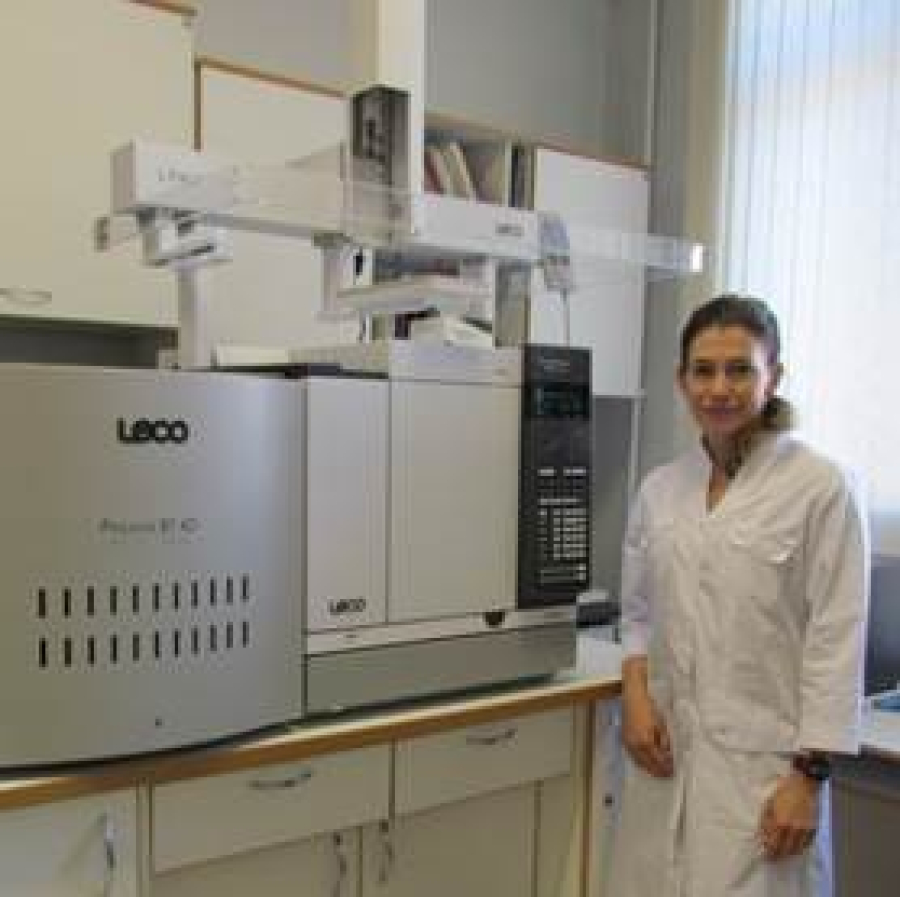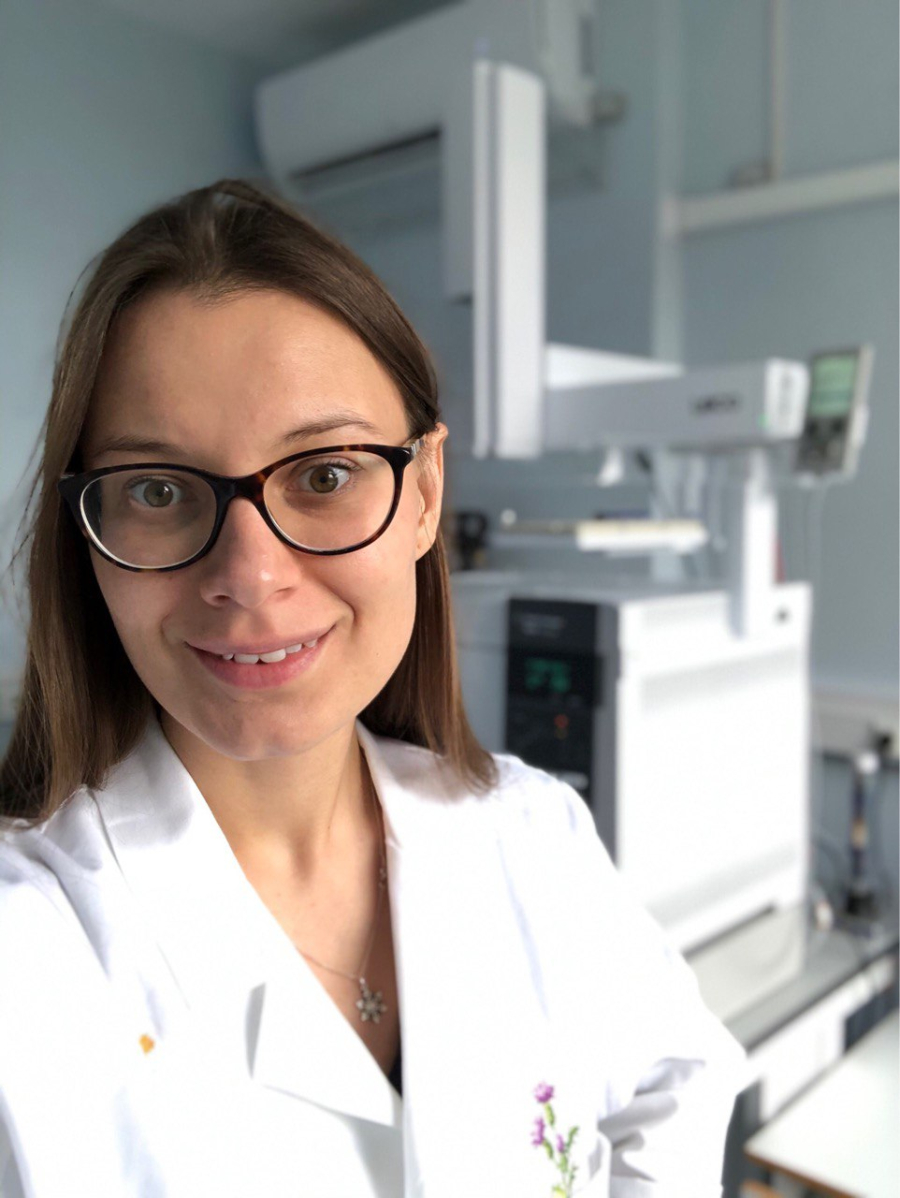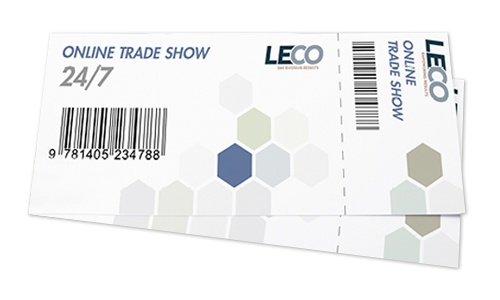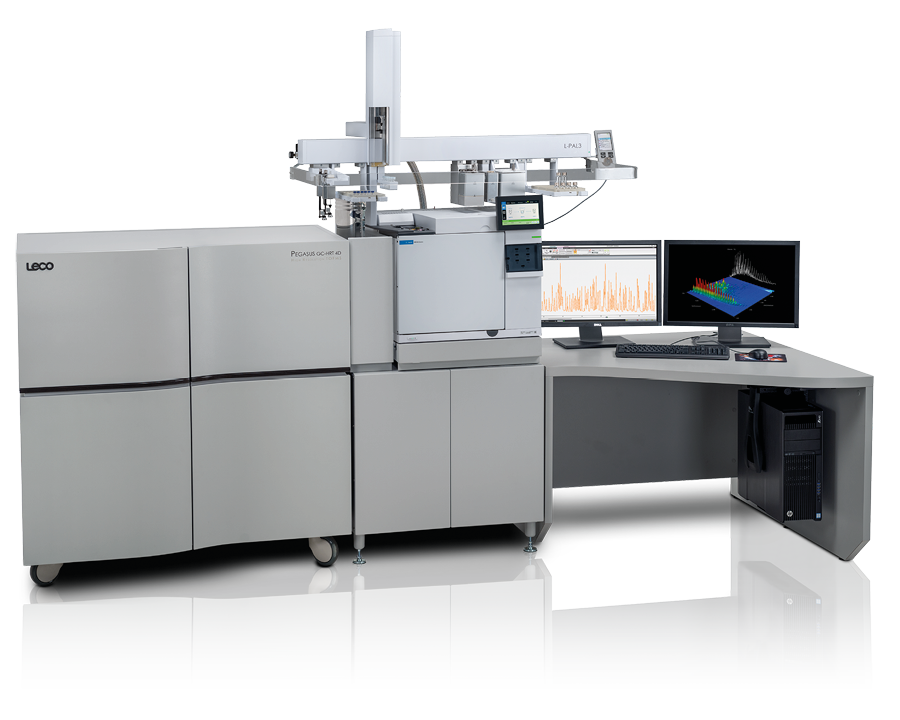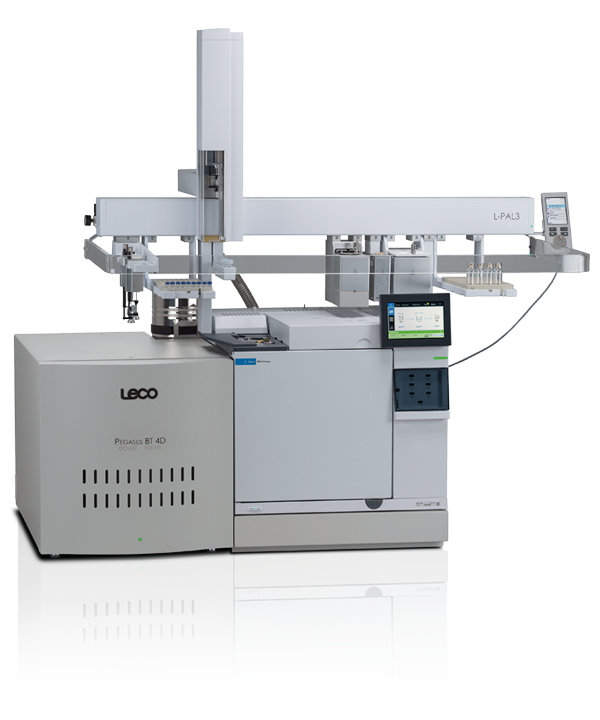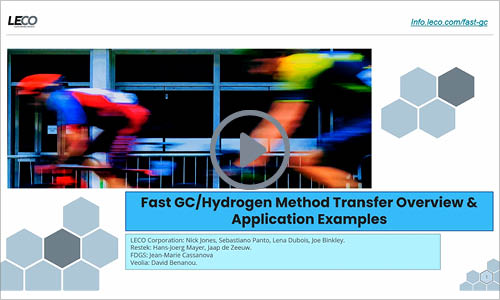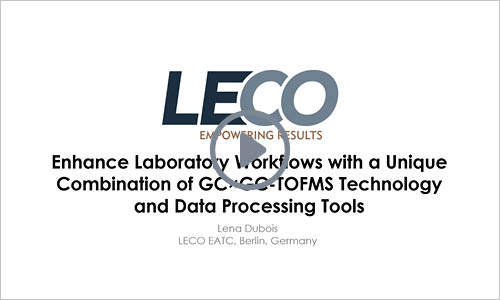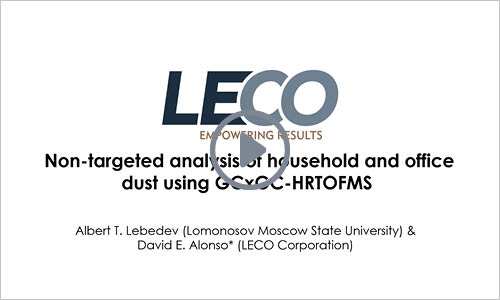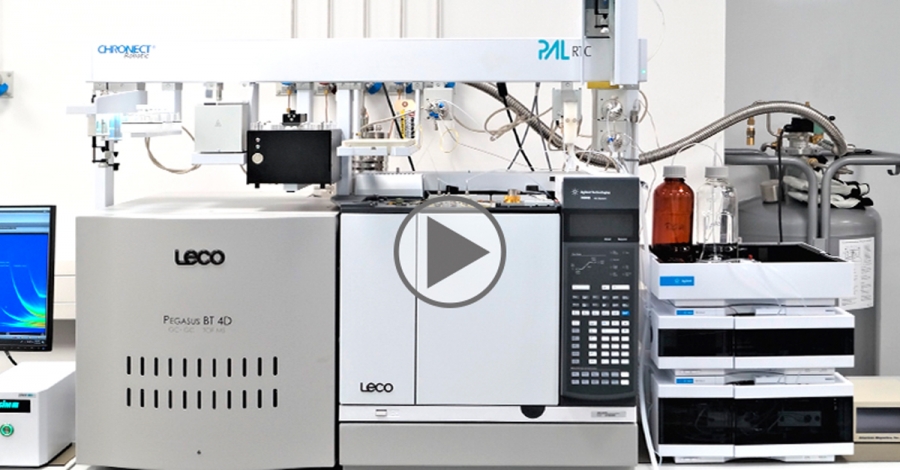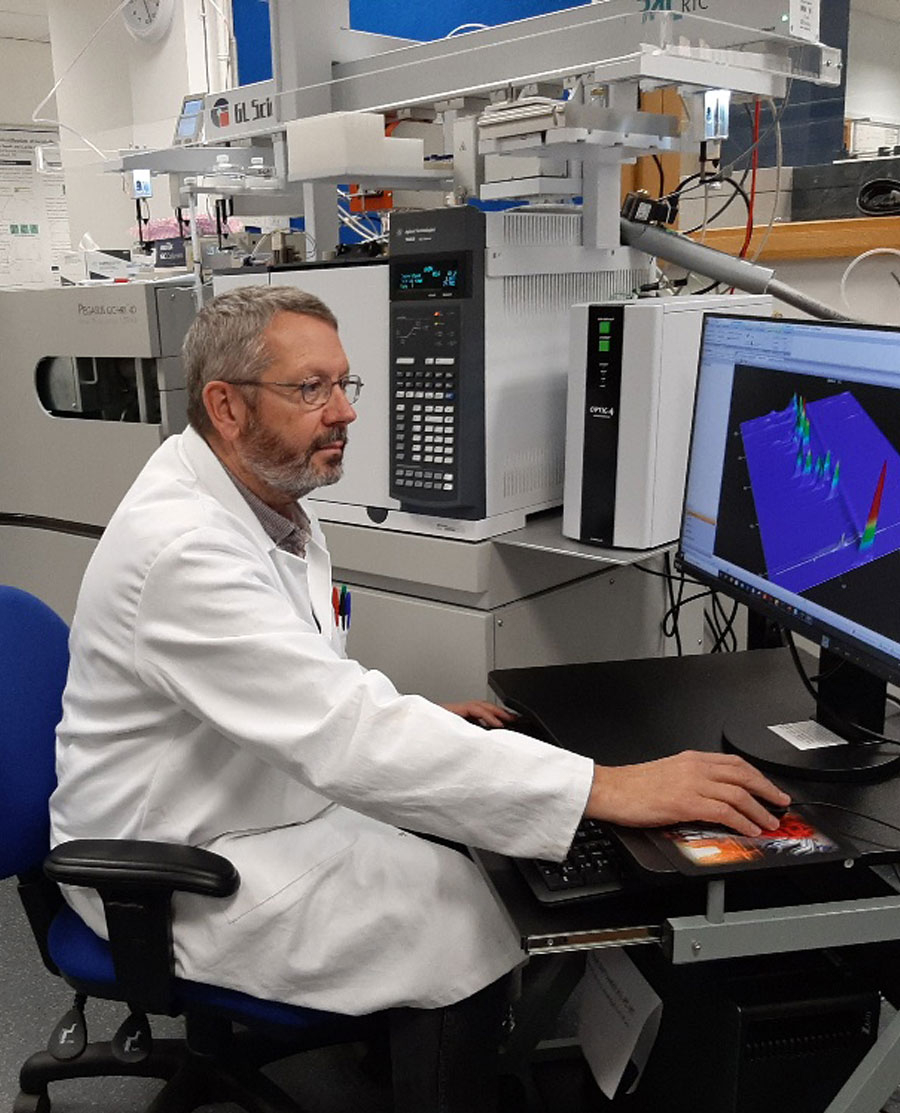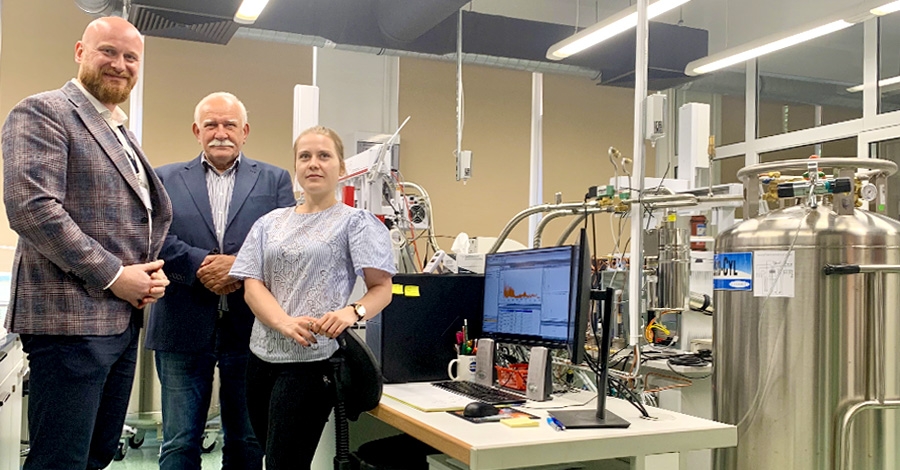
 LECO
Empowering Results
LECO
Empowering Results
Afficher les éléments par tag : Pegasus BT4D
I use LECO PEGASUS® BT 4D to separate, identify and quantify secondary metabolites of various organisms. The advantages of the GC×GC system in separation of multi-component mixtures allow us to separate and identify a huge number of compounds in every samples. The ability to separate and quantify low levels of target analytes in mixtures simultaneously with the major components presented at a high level of concentration and to separate coeluted compounds is a great advantage of two-dimensional GC in comparison with one-dimensional GC. The user-friendly ChromaTOF software and excellent technical support make LECO a reliable partner for researcher. Since we started working on this equipment, our results have become more accurate and comprehensive, and our research has reached a new level.
In our lab, the GC×GC-MS device installed by LECO has been a game-changer for metabolic profiling, especially in our multiomics study exploring the intricacies of obesity in young adults. Its sensitivity has been crucial in identifying and quantifying metabolites, even at low concentrations, essential for uncovering subtle changes in the metabolome. Our experience with PEGASUS® BT 4D device has been exceptionally positive, significantly due to the exceptional support of the service team, ensuring the smooth operation and optimal performance of our instrument.
Explore the Fascinating World of Separation Science
The very first GC-MS was a GC-TOFMS which was built in 1947. The information it provided was much too large to record, and it was not until the mid-1990s when LECO introduced the first fast GC-TOFMS, that GC-TOFMS became a useable tool for researchers and analysts. Followed a few years later by LECO’s introduction of the first GC×GC-TOFMS.
Today, LECO’s Separation Science products are recognised across the globe as leading advanced technology innovations in TOFMS Mass Spectrometry and Comprehensive two-dimensional Chromatography.
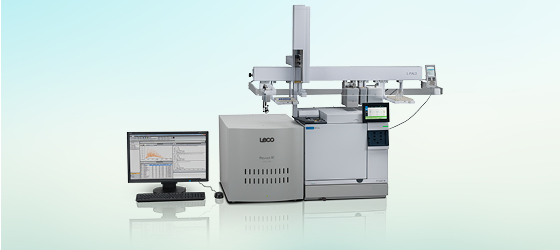
PEGASUS® BT GC-TOFMS
GC Time-Of-Flight Mass Spectrometer
Today‘s laboratories are being asked for more everyday – more samples run, more data acquired, more chemical information processed, and more results achieved – all in less time, for less money. ...
The Pegasus BT allows you to achieve all you need from a single sample run, while powerful and user-friendly ChromaTOF® software processes your data and removes the guesswork involved with analyte identification, quantitation, and reporting. The Pegasus BT gives users more uptime, better data, and an increase in overall productivity and efficiency.
Le spectromètre de masse à temps de vol (time-of-flight mass spectrometer, TOFMS) est idéal pour découvrir de nouveaux composés dans votre échantillon, pour quantifier des composés ciblés dans des échantillons complexes et pour augmenter le rendement car compatible avec la "fast GC".
► Download the free whitepaper and brochure
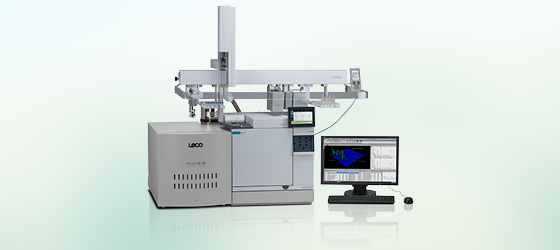
PEGASUS® BT 4D GCxGC-TOFMS
GC×GC Time-Of-Flight Mass Spectrometer
The Pegasus BT 4D offers enhanced sensitivity by coupling our benchtop Pegasus BT with a high-performance GC×GC modulation system. This combination gives the Pegasus BT 4D the ability to interrogate challenging samples ...
... where the best sensitivity is needed. Des fonctionnalités logiciel et instrument uniques et puissantes simplifient la quantification, ainsi que l’utilisation et la compréhension de la GCxGC. Our thermal modulation system, the QuadJet™, is recognised as the gold standard in GC×GC modulation, providing the highest sensitivity available on the market - ideal for analysing the most complex samples.
One of the main advantages of LECO’s GC×GC-TOFMS is its ability to provide vastly improved peak capacity and resolution than traditional GC-MS systems. It also offers comprehensive information about the sample by separating compounds based on two different properties (volatility and polarity). Combining GC×GC with TOFMS is an ultimate solution for the analysis of complex samples.
► Download the free brochure
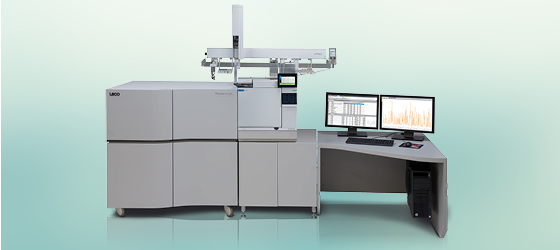
PEGASUS® GC-HRT+
High Resolution Time-Of-Flight Mass Spectrometer
Now with even more sensitivity than ever before, the Pegasus GC-HRT+ is the perfect tool for meeting the challenges of today’s highly complex analytical demands. ...
This high-resolution mass spectrometer features industry leading mass accuracy, full mass range acquisition with exceptional speed, full mass range acquisition with exceptional speed, isotopic abundance and mass resolution, all available in a single injection.
Folded Flight Path® (FFP®) technology and a novel data acquisition system enables simultaneous resolutions of over 50,000 FWHM, mass accuracies less than 1 ppm, and acquisition rates up to 200 spectra/second, without the need to adjust tuning or parameters. Thus, facilitating rich analyte finding and high-confidence analyte identification.
► Download the free brochure
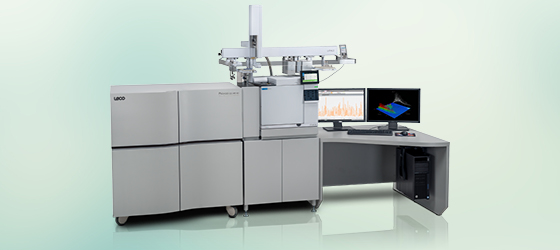
PEGASUS® GC-HRT+ 4D
HR GC×GC Time-Of-Flight Mass Spectrometer
The Pegasus GC-HRT+ 4D combines the highest performance GC×GC and TOFMS tools on the market with High Resolution Deconvolution® (HRD®). Ideal for the most complex samples, ...
... users are able to find more analytes than ever before and confidently identify unknown components.
The Pegasus GC-HRT+ 4D takes advantage of four dimensions of separation and resolution:
- 1st dimension chromatographic resolution
- 2nd dimension chromatographic resolution
- High mass resolution and exceptional mass accuracy
- High Resolution Deconvolution (HRD) from the leaders in deconvolution
ChromaTOF brand software, designed specifically for HRT+ instrumentation and GC×GC support, adds advanced qualitative and quantitative capabilities to an all-in-one user-friendly data system.
► Download the free brochure
Examples of LECO Separation Science Applications
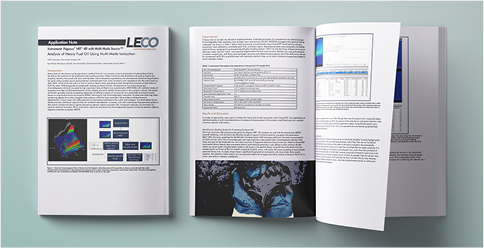
Pétrole
Comprehensive Two-Dimensional Gas Chromatography (GC×GC) has proven to be an extremely valuable analytical technique for the petroleum industry due to its ability to substantially increase the chromatographic peak capacity beyond that of traditional single-dimension gas chromatography. Pairing GC×GC with Time-of Flight Mass Spectrometry (TOFMS) provides unsurpassed characterization capabilities due to the separation power of GC×GC and the ability of TOFMS to provide rich data.
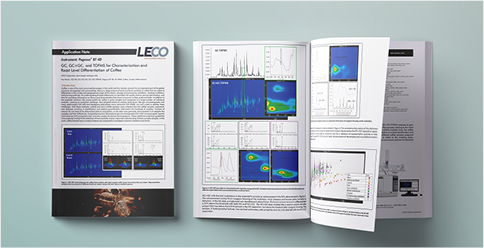
Food Testing
The characterization and safety testing of food and food constitutions can be extremely challenging depending on the complexity and the matrix. The LECO GC×GC TOFMS technology provides a highly powerful separation and remarkable identification allowing for improved workflows. More insights thanks to the advanced technology in combination with LECO’s ChromaTOF® brand software deconvolution algorithm and advanced data analysis tool will improve your Food Quality & Safety Testing and Food R&D. Here we demonstrate the aroma analsyis of two types of coffee and coffee packaging and filter leachates.

Perfume and Cosmetics
LECO‘s GC×GC-TOFMS is a valuable asset in the production of cosmetics and perfumes that align with Islamic principles. It can be used to identify the ingredients and detect any prohibited substances such as alcohol or non-halal animal-derived ingredients.
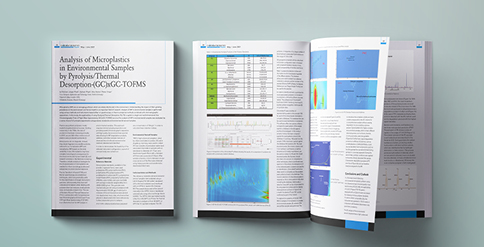
Analyse environnementale
Microplastics are an emerging pollutant which are widely distributed in the environment. Understanding the impact of their growing prevalence on the environment and human health is an important field of research. LECO‘s GC×GC-TOFMS can be used to monitor environmental pollution and air and water quality thus aiding to enforce regulations and ensure the preservation of our environment.

Métabolomique
LECO’s key advantage is the ability to identify and discover more metabolites than other similar technologies. La vitesse de notre acquisition en "full-scan" est incomparable, et si elle est combinée avec la puissance de l'algorithme de déconvolution du logiciel LECO ChromaTOF, permet une caractérisation des métabolomes sans précédent. Nos instruments ont été validés par les chercheurs les plus exigeants du domaine.
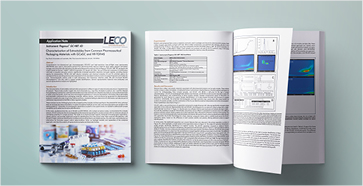
Extractables and Leachables
The characterization of extractable and leachable components from a wide range of materials is an important area of research. Information about extractable and leachable components from packaging and delivery devices for pharmaceutical products is a particular area of growing interest. Analytical testing results on this topic are part of many regulatory submission requirements to the FDA. ...
USP 1663 provides guidance on extractables testing and a variety of analytical approaches can meet compliance. High resolution MS is often considered necessary for identification of unknowns, and sample complexity and low-level detection continue to challenge these analyses. Here, we demonstrate a workflow that uses comprehensive two-dimensional gas chromatography (GC×GC) with HR-TOFMS to help address these challenges.
► App Note | Characterizing Extractables by GC×GC & HR-TOFMS
FAQ – Separation Science
Answer:
Gas chromatography separates components in a mixture by utilizing a thin silica tube coated with a stationary phase. The components, carried by a gas (the mobile phase), move at different speeds based on their affinities for the stationary phase. This differential migration leads to the separation of the components, allowing for their individual analysis and identification.
Alternative response:
- Gas chromatography is a technique for separating a mixture of volatile analytes
- The analytes are transported by a mobile phase (the carrier gas)
- Become distributed between the mobile phase and a stationary phase
- The Stationary Phase is attached to the inside of a very fine column
- Phases are typically characterised by their polarity
- A polar analyte will be retained by polar column for longer than a non-polar analyte
- and vica versa
Answer:
LECO uses Agilent 8890 chromatography. The gas chromatograph includes the following features:
- Compatibility and perfect integration with the mass spectrometer
- Automatic regulation of gas flows
- Agilent supported inlets: Split/Splitless (SSL), Multimode (MMI), Programmable temperature Vaporizer (PTV) etc.
- Programmable oven, up to 450 °C
- Chromatograph compatible with Fast-GC
- The GC is completely controlled by and integrated into LECO’s ChromaTOF software
Answer:
The LECO mass spectrometer is connected to the GC via a heated transfer line. The LECO GC-TOF allows you to have a 'full range' acquisition, without compromise, then a targeted and/or non-targeted data exploitation depending on what you want to do.
It consists of an EI (Electronic Impact) source, a 70 cm flight tube, a reflectron and a detector. Vacuum is provided by an internal turbomolecular pump connected to an external secondary pump.

Answer:
The mass range of the Pegasus BT is from 10 to 1500 m/z. All masses are collected all the time, unlike quadrupole instruments that collect a single mass at a time (quadrupole scanning mode is single ion monitoring, SIM, quickly scanning across the mass range).
Answer:
GC×GC-TOFMS can detect discrepancies in the composition of food products, helping to expose fraudulent claims of Halal certification and ensure consumer confidence in authentic Halal products.
Answer:
By examining the chemical composition of inks and pigments, GC×GC-TOFMS provides insights into the materials used in Islamic calligraphy and manuscripts, aiding in their preservation and authentication. An example of similar work can be read in this publication on analysing the paints used by Leonardo Da Vinci.
Answer:
LECO’s GC×GC-TOFMS system utilizes two columns with different separation mechanisms, providing enhanced chromatographic resolution for the analysis of complex mixtures. In one dimension the analytes are separated by polarity, or according to boiling point. An additional dimension separates according to an alternative property, of which there are many. This results in a 3D image – the two dimensions of separation and the abundance of the analytes in the third dimension.
Answer:
LECO's StayClean® ion source originates in the requirement for a fast source to match the speed of the TOFMS. Accomplished by reducing ion to ion interactions, such as with the walls of the source. The source was thus designed without walls – so there is nothing to clean. Massively reduced downtimes, especially for complex matrices and more reproducible results.
Answer:
Yes! With superior separation power and precision, LECO’s GC×GC-TOFMS system can uncover hidden details and confidently identify components, even in the most intricate mixtures:
- Increases detectability
- Removes analytes from matrix interference
- Separates co-elluting peaks
- Creates cleaner peaks, which match closer with libraries
- Creates structured chromatograms thus further improving identification confidence
Answer:
The cryogenic Quad Jet modulator consistently delivers reproducible quantitative results not only within the lab but also between labs worldwide. This is achieved because:
- There are two cold jets. So, eluent from the primary column does not flow into the secondary column by mistake
- The distance between cold zones is identical in every system worldwide, unlike other systems that require manual adjustment and intervention
- The modulation is completely computer controlled. This along with the 2 separate cold zones, allows for variable modulation periods in the same analysis, vastly improving separation across the chromatogram
- In the same way the primary column is temperature controlled in the primary oven, the secondary column is also independently controlled, allowing for total control of the chromatogram along the entire column setup
These four features not only improve separation and control, they are also unique to the LECO QuadJet.
Answer:
By combining comprehensive two-dimensional gas chromatography (GC×GC) with high-speed, high-sensitivity time-of-flight mass spectrometry (TOFMS), LECO's GC×GC-TOFMS can separate and identify the complex mixtures of flavours and fragrances in food samples with detail and precision.
Answer:
Yes! LECO’s GC×GC-TOFMS is an excellent tool for non-intentionally added substances (NIAS) analysis in food safety. It allows for the comprehensive analysis of complex food samples, ensuring the detection and identification of potential contaminants and unwanted substances. For example, LECO’s MOSH/MOAH solution is widely recognised as the most comprehensive and rigorous analyser for mineral oil contamination in food stuffs.
Answer:
LECO’s GC×GC technology utilizes two stages of separation, significantly increasing resolution and analysis power compared to traditional gas chromatography. This allows for the detailed separation and identification of complex mixtures with unparalleled precision.
Answer:
LECO’s TOFMS technology offers excellent sensitivity, speed, and resolution in mass spectrometry. By fragmenting and ionizing analyte molecules and separating the fragments based on their mass-to-charge ratio, LECO's TOFMS enables highly accurate identification and detection of compounds in samples. The system not only records to a computer at high speed, it detects at a rate of 32,000 Hz thus producing a very high level of accuracy.
Answer:
GC×GC-TOFMS enables the analysis of dietary supplements for the presence of non-compliant ingredients, such as animal-derived gelatine, ensuring that the products meet the strict requirements of Halal certification.
Answer:
GC×GC-TOFMS is a valuable tool for monitoring air and soil quality near Islamic sacred sites, identifying pollutants that may pose a risk to their preservation and guiding conservation efforts. As an example, Imperial College London have utilised a LECO Pegasus BT 4D to identify microplastics in the air of London. You can read about it here.
Answer:
LECO’s GC×GC-TOFMS system utilizes Time-of-Flight Mass Spectrometry (TOFMS), which provides high-speed detection of ionized compounds based on their mass-to-charge ratio.
Answer:
LECO provides software for data analysis, enabling compound identification, quantification, and other types of analysis based on the mass spectra obtained from the TOFMS.
Answer:
LECO’s StayClean ion source, a standard feature in every Pegasus BT GC-TOFMS and GC×GC-TOFMS system, flushes neutrals and contaminants continuously. This virtually eliminates the need for routine maintenance, allowing you to spend less time on upkeep and more time on your research.
Answer:
Sample handling is crucial in GC-MS analysis. LECO employs advanced sample handling robots called Autosamplers that can handle samples in three dimensions of space. These robots ensure precise and consistent sample preparation, ranging from simple liquid injections to complex processes like chemical reactions, extractions, and accurate dilutions.
Answer:
The first GC-MS was a GC-TOFMS developed in the 1950s. However, the technique was too powerful for data recording at the time. In the mid-1990s the first GC-TOFMS capable of recording the data for processing was developed by LECO. This breakthrough in fast GC-TOFMS technology allowed researchers and analysts to utilize the capabilities of GC-TOFMS for their analytical needs.
Answer:
By combining two-dimensional separation, robust ionization, and high-speed TOFMS detection, and patented deconvolution algorithms LECO's GC×GC-TOFMS system offers a powerful solution for analysing complex mixtures with enhanced resolution, sensitivity, and separation power.
Answer:
By analysing the chemical composition of materials used in ancient Islamic artifacts, GC×GC-TOFMS assists in determining their authenticity, providing valuable insights into historical and cultural heritage. The chemical composition of such artifacts are extremely complex so utilising multidimensional chromatography techniques with high speed TOFMS, a chemical profile can be created. Furthermore, LECO’s post processing software packages, ChromaTOF Tile and ChromaTOF Sync can identify differences between samples to compare artifacts and identify biomarkers.
Let LECO help you
find the right instruments for your needs.
Si vous souhaitez en savoir plus sur nos produits et solutions pour l’analyse de produits agroalimentaires, réservez un billet gratuit pour notre salon virtuel ou programmez une démonstration en ligne pour avoir un aperçu plus précis de nos instruments.
Explore the Fascinating World of Separation Science
The very first GC-MS was a GC-TOFMS which was built in 1947. The information it provided was much too large to record, and it was not until the mid-1990s when LECO introduced the first fast GC-TOFMS, that GC-TOFMS became a useable tool for researchers and analysts. Followed a few years later by LECO’s introduction of the first GC×GC-TOFMS.
Today, LECO’s Separation Science products are recognised across the globe as leading advanced technology innovations in TOFMS Mass Spectrometry and Comprehensive two-dimensional Chromatography.

PEGASUS® BT GC-TOFMS
GC Time-Of-Flight Mass Spectrometer
Today‘s laboratories are being asked for more everyday – more samples run, more data acquired, more chemical information processed, and more results achieved – all in less time, for less money. ...
The Pegasus BT allows you to achieve all you need from a single sample run, while powerful and user-friendly ChromaTOF® software processes your data and removes the guesswork involved with analyte identification, quantitation, and reporting. The Pegasus BT gives users more uptime, better data, and an increase in overall productivity and efficiency.
Le spectromètre de masse à temps de vol (time-of-flight mass spectrometer, TOFMS) est idéal pour découvrir de nouveaux composés dans votre échantillon, pour quantifier des composés ciblés dans des échantillons complexes et pour augmenter le rendement car compatible avec la "fast GC".
► Download the free whitepaper and brochure

PEGASUS® BT 4D GCxGC-TOFMS
GC×GC Time-Of-Flight Mass Spectrometer
The Pegasus BT 4D offers enhanced sensitivity by coupling our benchtop Pegasus BT with a high-performance GC×GC modulation system. This combination gives the Pegasus BT 4D the ability to interrogate challenging samples ...
... where the best sensitivity is needed. Des fonctionnalités logiciel et instrument uniques et puissantes simplifient la quantification, ainsi que l’utilisation et la compréhension de la GCxGC. Our thermal modulation system, the QuadJet™, is recognised as the gold standard in GC×GC modulation, providing the highest sensitivity available on the market - ideal for analysing the most complex samples.
One of the main advantages of LECO’s GC×GC-TOFMS is its ability to provide vastly improved peak capacity and resolution than traditional GC-MS systems. It also offers comprehensive information about the sample by separating compounds based on two different properties (volatility and polarity). Combining GC×GC with TOFMS is an ultimate solution for the analysis of complex samples.
► Download the free brochure

PEGASUS® GC-HRT+
High Resolution Time-Of-Flight Mass Spectrometer
Now with even more sensitivity than ever before, the Pegasus GC-HRT+ is the perfect tool for meeting the challenges of today’s highly complex analytical demands. ...
This high-resolution mass spectrometer features industry leading mass accuracy, full mass range acquisition with exceptional speed, full mass range acquisition with exceptional speed, isotopic abundance and mass resolution, all available in a single injection.
Folded Flight Path® (FFP®) technology and a novel data acquisition system enables simultaneous resolutions of over 50,000 FWHM, mass accuracies less than 1 ppm, and acquisition rates up to 200 spectra/second, without the need to adjust tuning or parameters. Thus, facilitating rich analyte finding and high-confidence analyte identification.
► Download the free brochure

PEGASUS® GC-HRT+ 4D
HR GC×GC Time-Of-Flight Mass Spectrometer
The Pegasus GC-HRT+ 4D combines the highest performance GC×GC and TOFMS tools on the market with High Resolution Deconvolution® (HRD®). Ideal for the most complex samples, ...
... users are able to find more analytes than ever before and confidently identify unknown components.
The Pegasus GC-HRT+ 4D takes advantage of four dimensions of separation and resolution:
- 1st dimension chromatographic resolution
- 2nd dimension chromatographic resolution
- High mass resolution and exceptional mass accuracy
- High Resolution Deconvolution (HRD) from the leaders in deconvolution
ChromaTOF brand software, designed specifically for HRT+ instrumentation and GC×GC support, adds advanced qualitative and quantitative capabilities to an all-in-one user-friendly data system.
► Download the free brochure
Examples of LECO Separation Science Applications

Pétrole
Comprehensive Two-Dimensional Gas Chromatography (GC×GC) has proven to be an extremely valuable analytical technique for the petroleum industry due to its ability to substantially increase the chromatographic peak capacity beyond that of traditional single-dimension gas chromatography. Pairing GC×GC with Time-of Flight Mass Spectrometry (TOFMS) provides unsurpassed characterization capabilities due to the separation power of GC×GC and the ability of TOFMS to provide rich data.

Food Testing
The characterization and safety testing of food and food constitutions can be extremely challenging depending on the complexity and the matrix. The LECO GC×GC TOFMS technology provides a highly powerful separation and remarkable identification allowing for improved workflows. More insights thanks to the advanced technology in combination with LECO’s ChromaTOF® brand software deconvolution algorithm and advanced data analysis tool will improve your Food Quality & Safety Testing and Food R&D. Here we demonstrate the aroma analsyis of two types of coffee and coffee packaging and filter leachates.

Perfume and Cosmetics
LECO‘s GC×GC-TOFMS is a valuable asset in the production of cosmetics and perfumes that align with Islamic principles. It can be used to identify the ingredients and detect any prohibited substances such as alcohol or non-halal animal-derived ingredients.

Analyse environnementale
Microplastics are an emerging pollutant which are widely distributed in the environment. Understanding the impact of their growing prevalence on the environment and human health is an important field of research. LECO‘s GC×GC-TOFMS can be used to monitor environmental pollution and air and water quality thus aiding to enforce regulations and ensure the preservation of our environment.

Métabolomique
LECO’s key advantage is the ability to identify and discover more metabolites than other similar technologies. La vitesse de notre acquisition en "full-scan" est incomparable, et si elle est combinée avec la puissance de l'algorithme de déconvolution du logiciel LECO ChromaTOF, permet une caractérisation des métabolomes sans précédent. Nos instruments ont été validés par les chercheurs les plus exigeants du domaine.

Extractables and Leachables
The characterization of extractable and leachable components from a wide range of materials is an important area of research. Information about extractable and leachable components from packaging and delivery devices for pharmaceutical products is a particular area of growing interest. Analytical testing results on this topic are part of many regulatory submission requirements to the FDA. ...
USP 1663 provides guidance on extractables testing and a variety of analytical approaches can meet compliance. High resolution MS is often considered necessary for identification of unknowns, and sample complexity and low-level detection continue to challenge these analyses. Here, we demonstrate a workflow that uses comprehensive two-dimensional gas chromatography (GC×GC) with HR-TOFMS to help address these challenges.
► App Note | Characterizing Extractables by GC×GC & HR-TOFMS
FAQ – Separation Science
Answer:
Gas chromatography separates components in a mixture by utilizing a thin silica tube coated with a stationary phase. The components, carried by a gas (the mobile phase), move at different speeds based on their affinities for the stationary phase. This differential migration leads to the separation of the components, allowing for their individual analysis and identification.
Alternative response:
- Gas chromatography is a technique for separating a mixture of volatile analytes
- The analytes are transported by a mobile phase (the carrier gas)
- Become distributed between the mobile phase and a stationary phase
- The Stationary Phase is attached to the inside of a very fine column
- Phases are typically characterised by their polarity
- A polar analyte will be retained by polar column for longer than a non-polar analyte
- and vica versa
Answer:
LECO uses Agilent 8890 chromatography. The gas chromatograph includes the following features:
- Compatibility and perfect integration with the mass spectrometer
- Automatic regulation of gas flows
- Agilent supported inlets: Split/Splitless (SSL), Multimode (MMI), Programmable temperature Vaporizer (PTV) etc.
- Programmable oven, up to 450 °C
- Chromatograph compatible with Fast-GC
- The GC is completely controlled by and integrated into LECO’s ChromaTOF software
Answer:
The LECO mass spectrometer is connected to the GC via a heated transfer line. The LECO GC-TOF allows you to have a 'full range' acquisition, without compromise, then a targeted and/or non-targeted data exploitation depending on what you want to do.
It consists of an EI (Electronic Impact) source, a 70 cm flight tube, a reflectron and a detector. Vacuum is provided by an internal turbomolecular pump connected to an external secondary pump.

Answer:
The mass range of the Pegasus BT is from 10 to 1500 m/z. All masses are collected all the time, unlike quadrupole instruments that collect a single mass at a time (quadrupole scanning mode is single ion monitoring, SIM, quickly scanning across the mass range).
Answer:
GC×GC-TOFMS can detect discrepancies in the composition of food products, helping to expose fraudulent claims of Halal certification and ensure consumer confidence in authentic Halal products.
Answer:
By examining the chemical composition of inks and pigments, GC×GC-TOFMS provides insights into the materials used in Islamic calligraphy and manuscripts, aiding in their preservation and authentication. An example of similar work can be read in this publication on analysing the paints used by Leonardo Da Vinci.
Answer:
LECO’s GC×GC-TOFMS system utilizes two columns with different separation mechanisms, providing enhanced chromatographic resolution for the analysis of complex mixtures. In one dimension the analytes are separated by polarity, or according to boiling point. An additional dimension separates according to an alternative property, of which there are many. This results in a 3D image – the two dimensions of separation and the abundance of the analytes in the third dimension.
Answer:
LECO's StayClean® ion source originates in the requirement for a fast source to match the speed of the TOFMS. Accomplished by reducing ion to ion interactions, such as with the walls of the source. The source was thus designed without walls – so there is nothing to clean. Massively reduced downtimes, especially for complex matrices and more reproducible results.
Answer:
Yes! With superior separation power and precision, LECO’s GC×GC-TOFMS system can uncover hidden details and confidently identify components, even in the most intricate mixtures:
- Increases detectability
- Removes analytes from matrix interference
- Separates co-elluting peaks
- Creates cleaner peaks, which match closer with libraries
- Creates structured chromatograms thus further improving identification confidence
Answer:
The cryogenic Quad Jet modulator consistently delivers reproducible quantitative results not only within the lab but also between labs worldwide. This is achieved because:
- There are two cold jets. So, eluent from the primary column does not flow into the secondary column by mistake
- The distance between cold zones is identical in every system worldwide, unlike other systems that require manual adjustment and intervention
- The modulation is completely computer controlled. This along with the 2 separate cold zones, allows for variable modulation periods in the same analysis, vastly improving separation across the chromatogram
- In the same way the primary column is temperature controlled in the primary oven, the secondary column is also independently controlled, allowing for total control of the chromatogram along the entire column setup
These four features not only improve separation and control, they are also unique to the LECO QuadJet.
Answer:
By combining comprehensive two-dimensional gas chromatography (GC×GC) with high-speed, high-sensitivity time-of-flight mass spectrometry (TOFMS), LECO's GC×GC-TOFMS can separate and identify the complex mixtures of flavours and fragrances in food samples with detail and precision.
Answer:
Yes! LECO’s GC×GC-TOFMS is an excellent tool for non-intentionally added substances (NIAS) analysis in food safety. It allows for the comprehensive analysis of complex food samples, ensuring the detection and identification of potential contaminants and unwanted substances. For example, LECO’s MOSH/MOAH solution is widely recognised as the most comprehensive and rigorous analyser for mineral oil contamination in food stuffs.
Answer:
LECO’s GC×GC technology utilizes two stages of separation, significantly increasing resolution and analysis power compared to traditional gas chromatography. This allows for the detailed separation and identification of complex mixtures with unparalleled precision.
Answer:
LECO’s TOFMS technology offers excellent sensitivity, speed, and resolution in mass spectrometry. By fragmenting and ionizing analyte molecules and separating the fragments based on their mass-to-charge ratio, LECO's TOFMS enables highly accurate identification and detection of compounds in samples. The system not only records to a computer at high speed, it detects at a rate of 32,000 Hz thus producing a very high level of accuracy.
Answer:
GC×GC-TOFMS enables the analysis of dietary supplements for the presence of non-compliant ingredients, such as animal-derived gelatine, ensuring that the products meet the strict requirements of Halal certification.
Answer:
GC×GC-TOFMS is a valuable tool for monitoring air and soil quality near Islamic sacred sites, identifying pollutants that may pose a risk to their preservation and guiding conservation efforts. As an example, Imperial College London have utilised a LECO Pegasus BT 4D to identify microplastics in the air of London. You can read about it here.
Answer:
LECO’s GC×GC-TOFMS system utilizes Time-of-Flight Mass Spectrometry (TOFMS), which provides high-speed detection of ionized compounds based on their mass-to-charge ratio.
Answer:
LECO provides software for data analysis, enabling compound identification, quantification, and other types of analysis based on the mass spectra obtained from the TOFMS.
Answer:
LECO’s StayClean ion source, a standard feature in every Pegasus BT GC-TOFMS and GC×GC-TOFMS system, flushes neutrals and contaminants continuously. This virtually eliminates the need for routine maintenance, allowing you to spend less time on upkeep and more time on your research.
Answer:
Sample handling is crucial in GC-MS analysis. LECO employs advanced sample handling robots called Autosamplers that can handle samples in three dimensions of space. These robots ensure precise and consistent sample preparation, ranging from simple liquid injections to complex processes like chemical reactions, extractions, and accurate dilutions.
Answer:
The first GC-MS was a GC-TOFMS developed in the 1950s. However, the technique was too powerful for data recording at the time. In the mid-1990s the first GC-TOFMS capable of recording the data for processing was developed by LECO. This breakthrough in fast GC-TOFMS technology allowed researchers and analysts to utilize the capabilities of GC-TOFMS for their analytical needs.
Answer:
By combining two-dimensional separation, robust ionization, and high-speed TOFMS detection, and patented deconvolution algorithms LECO's GC×GC-TOFMS system offers a powerful solution for analysing complex mixtures with enhanced resolution, sensitivity, and separation power.
Answer:
By analysing the chemical composition of materials used in ancient Islamic artifacts, GC×GC-TOFMS assists in determining their authenticity, providing valuable insights into historical and cultural heritage. The chemical composition of such artifacts are extremely complex so utilising multidimensional chromatography techniques with high speed TOFMS, a chemical profile can be created. Furthermore, LECO’s post processing software packages, ChromaTOF Tile and ChromaTOF Sync can identify differences between samples to compare artifacts and identify biomarkers.
Let LECO help you
find the right instruments for your needs.
Si vous souhaitez en savoir plus sur nos produits et solutions pour l’analyse de produits agroalimentaires, réservez un billet gratuit pour notre salon virtuel ou programmez une démonstration en ligne pour avoir un aperçu plus précis de nos instruments.
Expedite Gas Chromatography Analysis with Hydrogen
For years, helium has been the go-to choice as a carrier gas for mass spectrometers due to its well-known benefits. However, its limited supply and varying costs have posed significant challenges for labs worldwide.
LECO has conducted extensive research on the use of hydrogen as a carrier gas for GC-TOFMS analysis. We have developed innovative method transfer approaches to ensure a smooth and efficient transition to hydrogen. With our proven expertise in the hydrogen conversion process, we can help labs of all sizes achieve increased chromatographic throughput without sacrificing the sensitivity and accuracy they demand.
As the supply of helium continues to dwindle, the use of hydrogen as a carrier gas for GC applications has become an increasingly attractive option. With both benefits and drawbacks to consider, it requires the expertise of a dedicated team to determine the optimal approach.
In the following sections, we will share the details of our approach, including the method transfer approaches used, the technological benefits, and application examples. At LECO, we understand the importance of providing comprehensive information and support. That's why we have put together a range of resources specifically on hydrogen conversion, to help you make an informed decision.

Don‘t miss out on this unique opportunity!
We know how valuable your time is, so we‘re bringing the experts and resources closer to you to show you how LECO instrumentation and hydrogen carrier gas can revolutionize your analysis, with live demos of our instruments and software.
Instrument Portfolio for Hydrogen carrier gas
We understand that the conversion from helium to hydrogen carrier gas can be a crucial step in mass spectrometry, where speed and sensitivity are of utmost importance. At LECO, we take pride in designing our PEGASUS® mass spectrometers to deliver exceptional performance in Fast GC applications with both helium and hydrogen carrier gas. Our instruments are built to provide high-speed analysis without compromising sensitivity, making them the ideal choice for labs looking to switch to hydrogen. In addition, with our innovative StayClean® Ion Source technology, you can be confident that your instrument will operate at peak efficiency, free from the need for frequent cleaning and maintenance.
On-demand Videos & Presentations
Helium is becoming an increasingly limited natural resource; using Hydrogen to achieve increased chromatographic throughput in GC applications is attractive. Both have advantages and disadvantages. LECO has for years investigated the use of Hydrogen as a carrier gas for GC-TOFMS analysis. In the following we are going to present you the method transfer approaches used, the technological benefits, and application examples.
► „Fast GC / Hydrogen Method Transfer Overview & Application Examples“
by Nick Jones, Sebastiano Panto, Lena Dubois, Joe Binkley (LECO Corporation, St. Joseph, MI USA)
Please click here for watching the video ...
► „GC×GC Analysis with Chroma TOF Tile“
by Lena Dubois (LECO ETAC, Berlin, GER)
Please click here for watching the video ...
► „GC-MS Analysis Workflow utilizing ChromaTOF Sync“
by Liz Humstom-Fulmer (LECO Corporation, St. Joseph, MI USA)
Please click here for watching the video ...
► „Discovery Workflow Best Practices for Environmental Contaminants“
by Albert T. Lebedev (Lomonosov Moscow State University), David E. Alonso (LECO Corporation, St. Joseph, MI USA)
Please click here for watching the video ...

Webinar: Enhance Your GC-MS Workflow
With ever-increasing demands on your time, labor, and resources, optimizing your workflow is essential. Learn best approaches from GC-TOFMS experts to enhance your one- and two-dimensional gas chromatography applications (GC-MS and GC×GC-MS) in this webinar.
Library – Hydrogen Carrier Gas Publications
Read our following publications and discover more about GC-TOFMS analyses with hydrogen as a carrier gas.
Thank you for submitting the form. You now have access to all files.
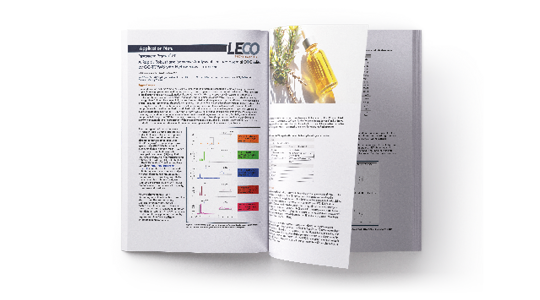
App Notes:
Hydrogen-based GC-TOFMS Analysis
The shortage of helium and its increased costs are encouraging laboratories to find suitable alternatives. Learn how LECO achieves quality results utilizing Hydrogen as a carrier gas.
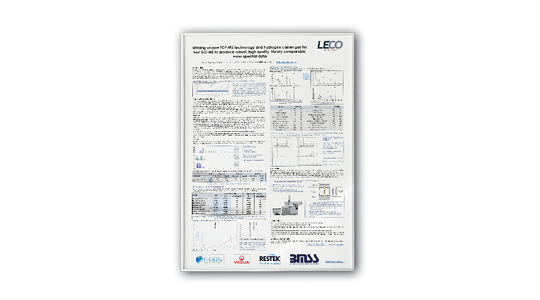
Poster:
„Utilizing unique TOF-MS technology and hydrogen carrier gas for fast GC-MS“
How many sample runs can you fit into your day? With a few simple changes, LECO‘s Pegasus BT can drastically speed up gas chromatography throughput. A faster time-of-flight analysis doesn‘t need to mean lower quality results.

Article:
„A green and sustainable method for Capsicum [...] using H2 Carrier Gas“
Learn how scientists from the University of Messina (Italy) increased their sustainability and „greenified“ their pepper analyses utilizing LECO separation science instruments.
Intéressé ?
We welcome the opportunity to discuss how hydrogen conversion can benefit your lab.
Get in touch with us today to learn more.
If you want to learn more about our products and solutions for Fast GC analysis, book a free ticket to our Virtual Trade Show, or schedule an online demo for a deeper insight in our instruments.
Expedite Gas Chromatography Analysis with Hydrogen
For years, helium has been the go-to choice as a carrier gas for mass spectrometers due to its well-known benefits. However, its limited supply and varying costs have posed significant challenges for labs worldwide.
LECO has conducted extensive research on the use of hydrogen as a carrier gas for GC-TOFMS analysis. We have developed innovative method transfer approaches to ensure a smooth and efficient transition to hydrogen. With our proven expertise in the hydrogen conversion process, we can help labs of all sizes achieve increased chromatographic throughput without sacrificing the sensitivity and accuracy they demand.
As the supply of helium continues to dwindle, the use of hydrogen as a carrier gas for GC applications has become an increasingly attractive option. With both benefits and drawbacks to consider, it requires the expertise of a dedicated team to determine the optimal approach.
In the following sections, we will share the details of our approach, including the method transfer approaches used, the technological benefits, and application examples. At LECO, we understand the importance of providing comprehensive information and support. That's why we have put together a range of resources specifically on hydrogen conversion, to help you make an informed decision.

Don‘t miss out on this unique opportunity!
We know how valuable your time is, so we‘re bringing the experts and resources closer to you to show you how LECO instrumentation and hydrogen carrier gas can revolutionize your analysis, with live demos of our instruments and software.
Instrument Portfolio for Hydrogen carrier gas
We understand that the conversion from helium to hydrogen carrier gas can be a crucial step in mass spectrometry, where speed and sensitivity are of utmost importance. At LECO, we take pride in designing our PEGASUS® mass spectrometers to deliver exceptional performance in Fast GC applications with both helium and hydrogen carrier gas. Our instruments are built to provide high-speed analysis without compromising sensitivity, making them the ideal choice for labs looking to switch to hydrogen. In addition, with our innovative StayClean® Ion Source technology, you can be confident that your instrument will operate at peak efficiency, free from the need for frequent cleaning and maintenance.
On-demand Videos & Presentations
Helium is becoming an increasingly limited natural resource; using Hydrogen to achieve increased chromatographic throughput in GC applications is attractive. Both have advantages and disadvantages. LECO has for years investigated the use of Hydrogen as a carrier gas for GC-TOFMS analysis. In the following we are going to present you the method transfer approaches used, the technological benefits, and application examples.
► „Fast GC / Hydrogen Method Transfer Overview & Application Examples“
by Nick Jones, Sebastiano Panto, Lena Dubois, Joe Binkley (LECO Corporation, St. Joseph, MI USA)
Please complete our form to watch the videos on-demand.
► „GC×GC Analysis with Chroma TOF Tile“
by Lena Dubois (LECO ETAC, Berlin, GER)
Please complete our form to watch the videos on-demand.
► „GC-MS Analysis Workflow utilizing ChromaTOF Sync“
by Liz Humstom-Fulmer (LECO Corporation, St. Joseph, MI USA)
Please complete our form to watch the videos on-demand.
► „Discovery Workflow Best Practices for Environmental Contaminants“
by Albert T. Lebedev (Lomonosov Moscow State University), David E. Alonso (LECO Corporation, St. Joseph, MI USA)
Please complete our form to watch the videos on-demand.

Webinar: Enhance Your GC-MS Workflow
With ever-increasing demands on your time, labor, and resources, optimizing your workflow is essential. Learn best approaches from GC-TOFMS experts to enhance your one- and two-dimensional gas chromatography applications (GC-MS and GC×GC-MS) in this webinar.
Library – Hydrogen Carrier Gas Publications
Read our following publications and discover more about GC-TOFMS analyses with hydrogen as a carrier gas. We kindly ask you to submit our form. Afterwards you‘ll get access to all files.

App Notes:
Hydrogen-based GC-TOFMS Analysis
The shortage of helium and its increased costs are encouraging laboratories to find suitable alternatives. Learn how LECO achieves quality results utilizing Hydrogen as a carrier gas.
„Analsysis of Teatree Oil“
„Citrus Essential Oils“

Poster:
„Utilizing unique TOF-MS technology and hydrogen carrier gas for fast GC-MS“
How many sample runs can you fit into your day? With a few simple changes, LECO‘s Pegasus BT can drastically speed up gas chromatography throughput. A faster time-of-flight analysis doesn‘t need to mean lower quality results.

Article:
„A green and sustainable method for Capsicum [...] using H2 Carrier Gas“
Learn how scientists from the University of Messina (Italy) increased their sustainability and „greenified“ their pepper analyses utilizing LECO separation science instruments.
Intéressé ?
We welcome the opportunity to discuss how hydrogen conversion can benefit your lab.
Get in touch with us today to learn more.
If you want to learn more about our products and solutions for Fast GC analysis, book a free ticket to our Virtual Trade Show, or schedule an online demo for a deeper insight in our instruments.
"I have used the LECO BT4D for the separation, identification, and quantification of anabolic steroids.
The advantages of the GC×GC system to separate stereoisomers in a complex matrix means time can be saved from doing complex sample preparation and extraction procedures. The ability to separate and quantify low levels of target analytes from high levels of matrix interferences has been key to my work. With LECO’s user-friendly ChromaTOF software, expert application scientists, and fantastic technical service team, LECO is a reliable and trusted research partner."
University of Southampton
"In 2019 EPSRC funded our vision for a regional Centre of Excellence (CoE) in 2 dimensional gas chromatography and mass spectrometry. This Regional CoE, initially embracing the Universities of Bath, Portsmouth, Southampton, and Swansea, will significantly drive discovery, characterisation and quantification of new modalities, delivering a step change in capability for detection and identification of new species that cannot be separated and determined by 1D GC alone.
LECO’s Pegasus HRT 4D GC×GC-TOFMS and the benchtop BT4D GC×GC-TOFMS, both with extensive automated sample handling capability were delivered in late 2019 and early 2020. Installation of these state-of-the-art instruments was complicated by Covid-19 and lockdown 1.0. With such complex instrumentation, and application areas, effective training was key; here LECO took the initiative and provided both bespoke local and on-demand online training.
The level of service support and close collaborative relationship with LECO (applications team and account manager) has been first rate. Both systems can now be operated remotely, enabling high level users from across the South West region to access the instrumentation and allow many complex questions to be probed. Our work covers a vast array of application, e.g. petrochemical, environmental and metabolomics. The data sets are rich and complex, yet simplified by a user friendly software interface. Compared to 1D-GC, the 4D systems provide an astonishing number of additional analyte identifications, giving us deeper insight and understanding of the samples. Combining LECO’s high resolution mass spectrometry with comprehensive gas chromatography, multiple sample handling options such as SPME, Pyrolysis and TD along with full automation has created a world class laboratory of which we are all very proud."
Les présentations suivantes sont disponibles :
Présentation de LECO à l’EURO Fed Lipid 2021
Réalisée en anglais
- « 18th Euro Fed Lipid Congress and Expo, 21 octobre 2021 »
Les fondamentaux sur l'analyse compréhensive des MOSH/MOAH
Réalisée en anglais
- « Principes de base du couplage LC-CG » par Dr Andreas Bruchmann | Axel Semrau GmbH & Co KG
- « Principes et instrumentation de GCxGC et TOF-MS » du Pr. Dr. Ir. Hans-Gerd Janssen | Université de Wageningen & Unilever
- « LC–GC×GC–ToF-MS/FID: A Powerful Platform for MOSH&MOAH Determination (LC–GC×GC–ToF-MS/Détecteur à ionisation de flamme (FID) : une plateforme puissante pour la détermination des teneurs en MOSH et en MOAH) » par la professeure Giorgia Purcaro | Université de Liège
Langue espagnole
- « Cromatografía Bidimensional Exhaustiva acoplada a Espectrometría de Masas de Tiempo de Vuelo: Características y viabilidad para el control y análisis alimentario » de Lourdes Ramos | CSIC-IQOG
- « Contamination MOSH / MOAH. Verificación mediante GC×GC-TOF-MS" de Silvia Losa | SGS Berlin
Nos dernières présentations sur l'analyse des MOSH/MOAH sont disponibles à la demande. Avec ces fondamentaux vous apprendrez tous les tenants et les aboutissants de la LC-GC couplée à la GCxGC et au spectromètre de masse à Temps de Vol pour l'analyse des MOSH/MOAH dans les produits alimentaires.
Nous sommes fiers d'annoncer la livraison et l'installation réussies d'un ensemble d'appareils unique chez notre client unique. NOFER INSTITUT DE MÉDECINE DU TRAVAIL à Łódź, qui comprend le DÉPARTEMENT DE SURVEILLANCE BIOLOGIQUE ET DE L’ENVIRONNEMENT, dirigé par le Prof. Dr. hab. n. med. Wojciech Wąsowicz, est un centre florissant et de formation d'opinion, participant à de nombreux programmes nationaux et internationaux.
Faculty of Forestry and Wood Sciences, Czech University of Life Sciences Prague, Czech Republic
"I have been working with LECO instruments for approx. ten years. I worked with the PEGASUS® 4D, TruTOF, GC-HRT and, for few days in Berlin, with the Pegasus BT and BT 4D – I really enjoyed that. There are several reasons why I like working with the devices and why I would not consider using other GC-MS insturments.
- LECO instruments are reliable and robust with well working peak find and mass spectral deconvolution algorithms.
- In principle, LECO instruments are allowing both target and non target analysis which can be performed in one run, with nice sensitivity.
- Data processing is easy and everything is done in one SW – no need to use complicated combinations of SWs.
- LECO has an excellent customers support"
Wolfson Atmospheric Chemistry Laboratories, University of York
"Following years of service from the old LECO PEGASUS® 4D TOF GC-MS, we upgraded to a new LECO Pegasus BT4D TOF GC-MS. The decision was made due to the exceptional separating power afforded by thecryogenic modulation and the durability of the LECO StayClean® sourcetechnology which has been carried into the updated system. The combination of the two open up a wide variety of analyses to us whichenable use of this instrument in many aspects of our research."
Department of Civil Engineering University of Strathclyde
"In 2013, I became responsible for overseeing the department’s analytical suite which included a LECO PEGASUS® 4D GC×GC TOF MS as our flagshipinstrument. I had no experience in gas chromatography and found even a standard GCMS daunting. Over the past years, I received extensive support from LECO. Especially withsupport from LECO UK the instrument is still running strong a decade after purchase. I anticipate it will go for another decade and then some."
Università degli Studi del Piemonte Orientale, Italy
"With the Pegasus BT 4D performing untargeted analysis today is very easy, thanks to the high sensitivity of the instrument, we are able to mine and analyze any type of sample! A combination of very good sensitivity, quality to price ratio and high flexibility make the Pegasus BT 4D system perfect for analysis of every sample"
